Student Stars are Shining Lights on Public Health
- By: The Public Health Learning Network
- Date
 Among their many aims, goals, and responsibilities, the Public Health Learning Network’s (PHLN) 10 regional public health training centers are committed to establishing and strengthening field placements for students in public or nonprofit private health agencies or organizations.
Among their many aims, goals, and responsibilities, the Public Health Learning Network’s (PHLN) 10 regional public health training centers are committed to establishing and strengthening field placements for students in public or nonprofit private health agencies or organizations.
Each training center provides field placement stipends of $1,500 to 20 students each year. Placements offer structured opportunities for students to apply to a practice-based setting what they’ve learned in the classroom. A placement is expected to contribute to the student’s mastery of public health competencies while balancing the needs of the community with the educational and practice needs of students. In addition to adhering to Health Resources and Services Administration program requirements, PHLN members, as Council on Education for Public Health (CEPH) accredited schools of public health, must develop and implement student field placements and faculty student collaborative field projects in accordance with CEPH guidelines.
Qualified stipend applicants are typically graduate or doctoral students with a demonstrated interest in public health. The PHLN encourages faculty-student partnerships and collaborative, hands-on learning experiences in underserved communities.
With pride and delight, we’re pleased to present a constellation of student stars making critical contributions to a public health organization near you!
Public Health 3.0 Comes Alive for this University of Connecticut Student
A Data Dive Shows the Relationship Between Diabetes Mortality and Community Wealth
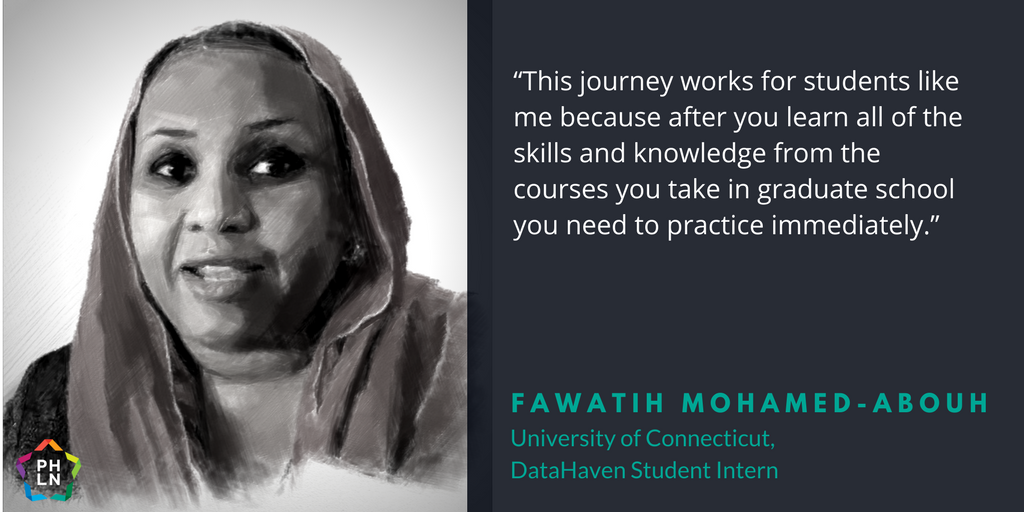
Public Health 3.0, a suite of cutting-edge approaches for upgrading public health practice, is built on understanding and addressing the social determinants of health. Fawatih Mohamed-Abouh, recent University of Connecticut (UConn) MPH graduate with a concentration in Community Medicine and Health Care, joined a research team that was doing exactly that: using advanced database and mapping techniques to find the correlation between diabetes mortality and the wealth of the community.
Supported by Region I – New England Public Health Training Center, Fawatih applied the skills she’d learned in the classroom to the statistical analysis, but she says the mapping work was new to her. Collaborating with experts in a real-world project was a great way to learn the techniques, she says. And the results of the study were striking: Statewide, diabetics in lower-wealth communities in Connecticut faced a range of challenges that were not seen in higher-wealth areas, from access to food at regular intervals, to lack of money for medication and lacking access to medical care. Challenges like these help to explain the strong correlation between diabetes mortality and a person’s income.
Fawatih now works as a Research Assistant at UConn Health.
Listen to Fawatih Mohamed-Abou’s describe the benefits of her internship experience »
Interns Make a Difference—and Make History
Learning Public Health 101 in the U.S. Virgin Islands Department of Health Chronic Disease Prevention Program
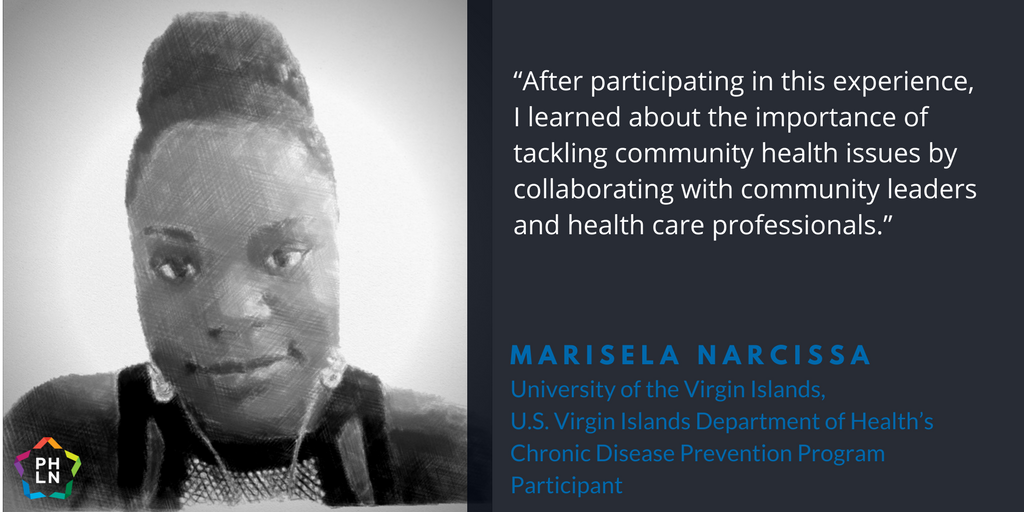
Local students with an interest in public health degree programs don’t yet have a home at the University of the Virgin Islands (UVI). However, in a collaboration with Columbia University, the Community Engagement and Lifelong Learning Center at UVI developed a public health training work plan for nursing students and proposed that the Health Resources and Services Administration consider interns from the UVI nursing program. The first two interns—rising seniors in the nursing program—wasted no time once the plan was accepted. Each gained a certificate in Public Health 101, giving them a foundation for their program. In just five weeks, they:
- Updated the USVI Health Care provider list for community distribution, which includes hours of operation, specialization and accepted insurance.
- Developed a patient-centered PowerPoint presentation on hypertension and cardiovascular disease for community leaders to spread awareness of prevention, treatment and risks to overall health.
- Conducted blood pressure screenings at two HIV/AIDS outreach events.
- Worked in Community Health Clinics taking blood pressure measurements and providing information to patients.
Talk about a win-win. The students took part in the cardiovascular disease prevention program and helped move the Department of Health’s initiative forward. The Region II – Region 2 Public Health Training Center and HRSA also gained an avenue to encourage nursing students in the Virgin Islands to join the field of public health.
Learning on the Front Lines of Emergency Operations
Floods Upend an Internship in West Virginia
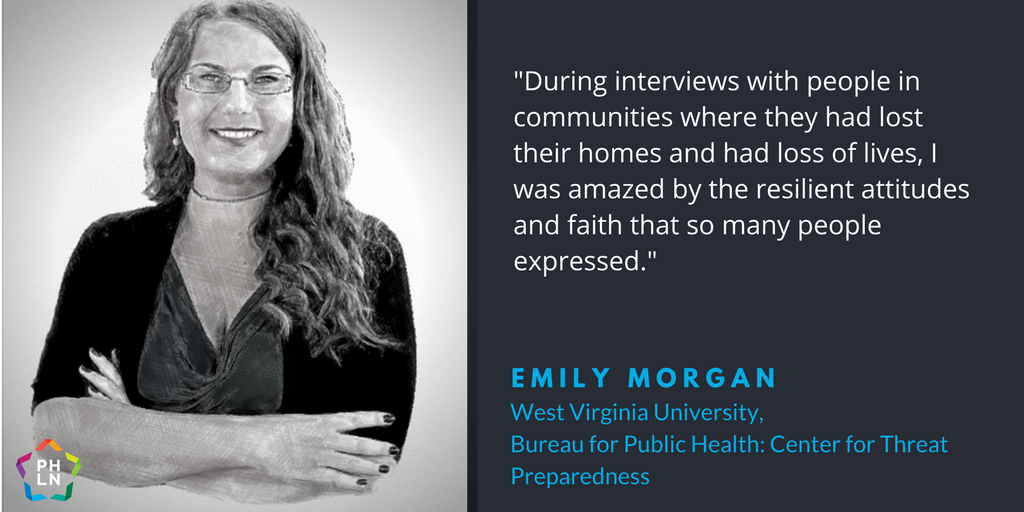
When West Virginia University epidemiology student Emily Morgan planned her internship (via Region III – Mid-Atlantic Regional Public Health Training Center) with West Virginia’s Center for Threat Preparedness at the Bureau for Public Health in Charleston, she thought she’d be working to develop a Zika virus toolkit. But continuous rain led to unprecedented flooding, and she learned first-hand how an Emergency Operations Center uses the national standard Incident Command System for health-related resource coordination and advisement. Shadowing Health Command staff, Emily contacted affected health departments of the 44 counties under a state of emergency to determine staffing needs and coordinate volunteer responses. She also joined approximately 50 Bureau for Public Health volunteers and three other WVU students to conduct a Community Assessment of Public Health Emergency Response.
After experiencing public health in action, Emily’s now chosen her path, and has applied to the CDC’s Public Health Associates Program.
Diving Into Data in Kentucky
Exploring the Relationships Between Influenza Deaths and Extremely Cold Temperatures as Well as Dust and Pulmonary Disease
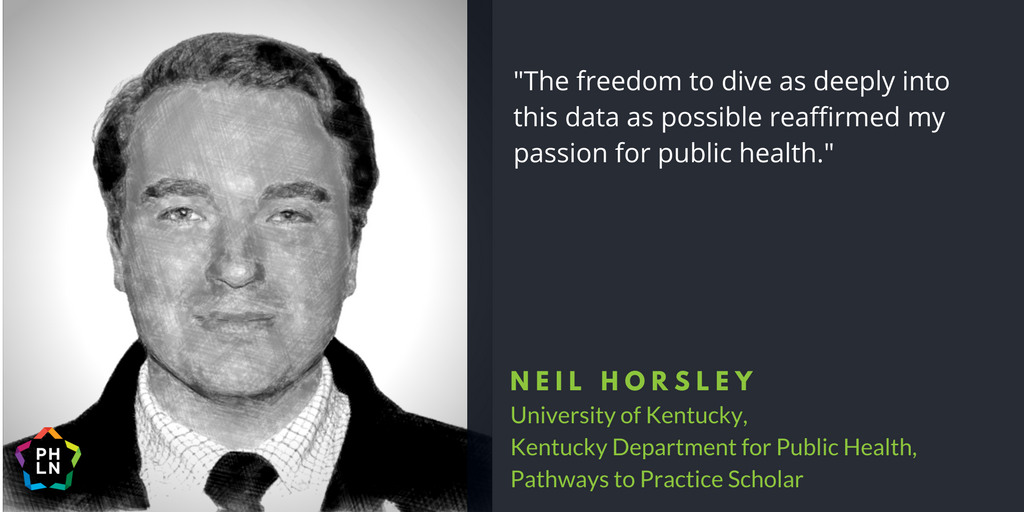
University of Kentucky Master of Public Health degree candidate Neil Horsley joined the state health department’s immunization program as a Pathways to Practice Scholar of the Region IV Public Health Training Center. Working on various projects in infectious disease and epidemiology, his research findings apply to policy that aims to improve health outcomes in the region. For one project, he conducted a literature review and data analysis of area influenza deaths and the potential correlation between spikes in influenza mortality and extremely cold ambient temperatures. In another, he used death certificate data provided by the state to conduct a regression analysis on the relationship between having worked in a “dusty” occupation (working with considerable airborne particulate exposure) and increased pulmonary disease mortality rates.
Now attending the University of Kentucky’s College of Medicine, Neil is in the Rural Physician Leadership Program, which emphasizes rural and community medicine in underserved populations.
Learn more about this Region IV Public Health Training Center success story »
Preventing Neonatal Abstinence Syndrome
Informing Policy While Interning in Tennessee
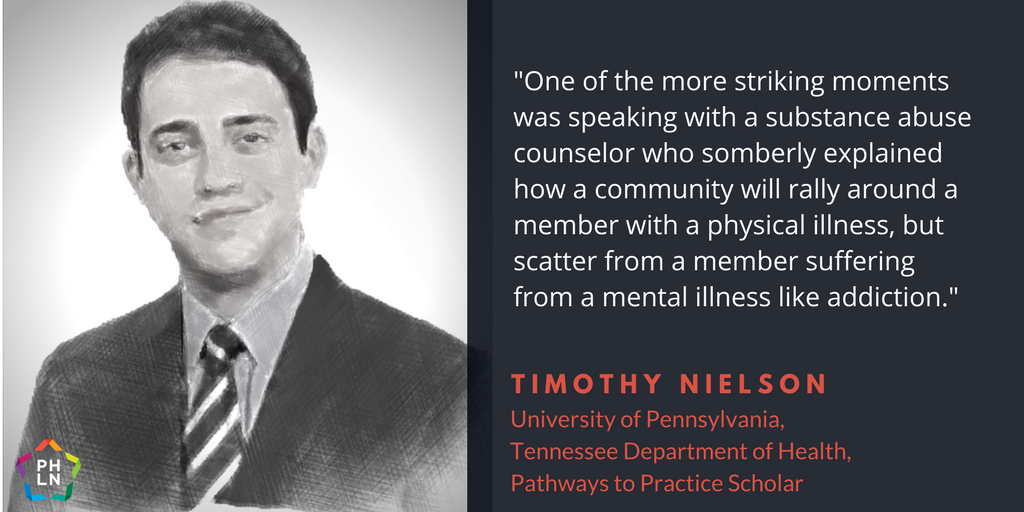
After finishing a Chemistry degree at the University of Pennsylvania, Timothy Nielson was selected as a Pathways to Practice Scholar of the Region IV Public Health Training Center. His work with mentor John Dreyzehner, MD, MPH, FACOEM, Commissioner of Health for the State of Tennessee, resulted in a number of key recommendations for preventing Neonatal Abstinence Syndrome (NAS), the withdrawal symptoms that affect newborns exposed to certain substances in utero, like opioids and benzodiazepines. The state is experiencing an NAS epidemic, and Timothy gathered information from state agencies and healthcare providers to inform several policy recommendations. These include expanding education to providers, connecting mothers to resources, standardizing follow up, and increasing funds for substance abuse treatment, particularly with a family centered approach.
Timothy is now completing an Applied Epidemiology Fellowship of the Council of State and Territorial Epidemiologists (CSTE) in Maternal Child Health at Massachusetts Department of Public Health.
Learn more about this Region IV Public Health Training Center success story »
A Summer with Medically Underserved Communities in Georgia
Exploring Rural Healthcare Needs
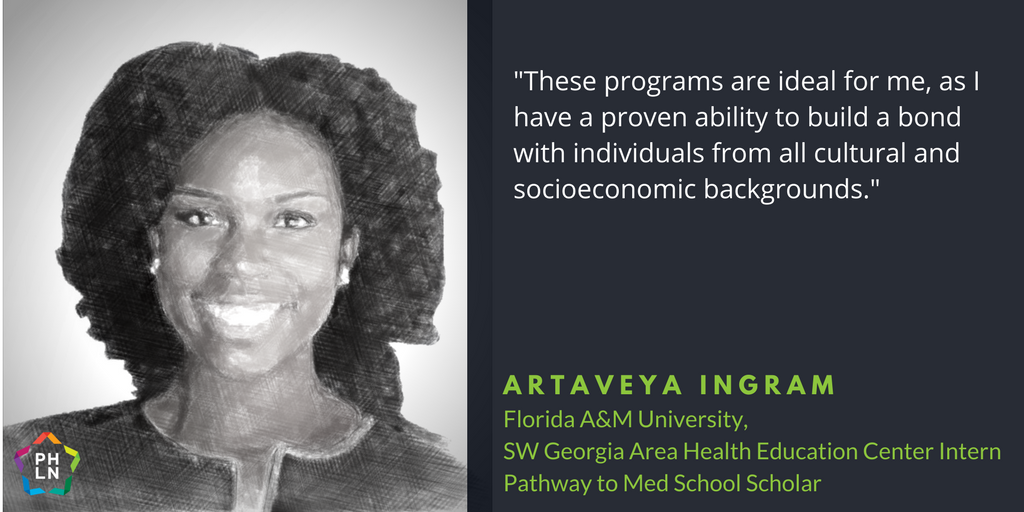
Last summer, Artaveya, a Florida A&M MPH candidate, completed an internship at the Southwest Georgia Area Health Education Center in Albany, Georgia. Her program was designed to encourage pre-med students to pursue a medical career in primary care and return to rural areas as providers. She also worked on the Migrant & Farmworker Family Health Program, which brings teams of providers from cities into rural communities to provide healthcare to underserved migrant and seasonal farm workers and their families.
Artaveya recently graduated from Florida A&M, and today works as a Research Scientist at Centers for Disease Control and Prevention in upstate New York.
Learn more about this Region IV Public Health Training Center success story »
Connecting Veterinary Medicine and Public Health
First-hand Experience of the Link Between Pet Care and Their Owner’s Health and Well Being
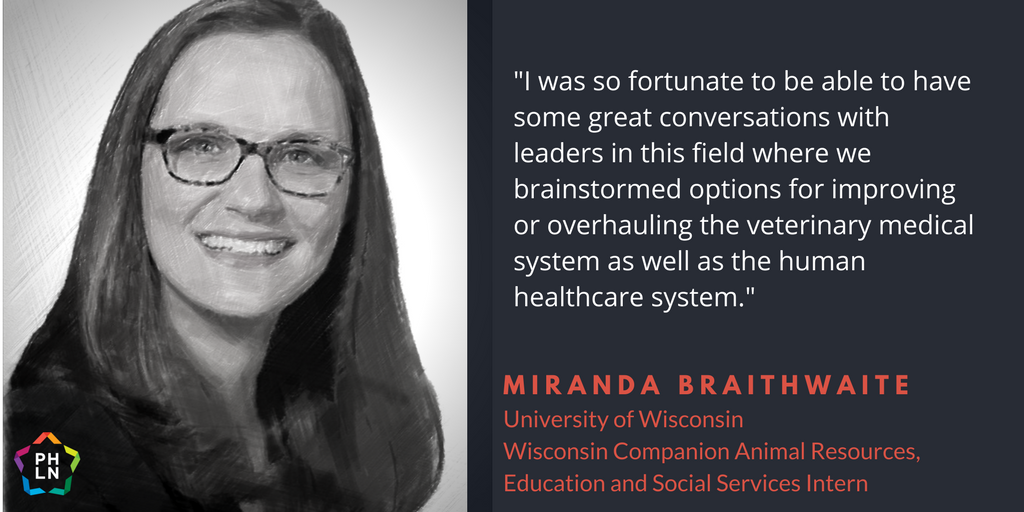
With the help of Region V – Great Lakes Public Health Training Collaborative, Miranda Braithwaite, a University of Wisconsin-Madison DVM-MPH candidate, completed her public health field experience with the Wisconsin Companion Animal Resources, Education and Social Services (WisCARES), which provides no-cost veterinary care for the homeless population in Dane County, Wisconsin. “I really wasn’t sure at the beginning of the summer how my fieldwork would build upon my coursework. The work of WisCARES was flirting with public health, but I really didn’t understand how,” she said. “My understanding of how WisCARES really is public health expanded dramatically over the summer. I really was able to have a first-hand account of many of the issues our clients face when trying to get access to medical care for themselves. Additionally, I was able to see the analogies to veterinary medical care.”
Evidence from WisCARES and other programs has determined that providing veterinary care for the pets of homeless people increases the health and well-being of the pet owners, often enabling them to be more willing to seek care for their own needs.
Food, Nutrition, and Public Health
Seeing Big Possibilities in Food and Nutrition Programs
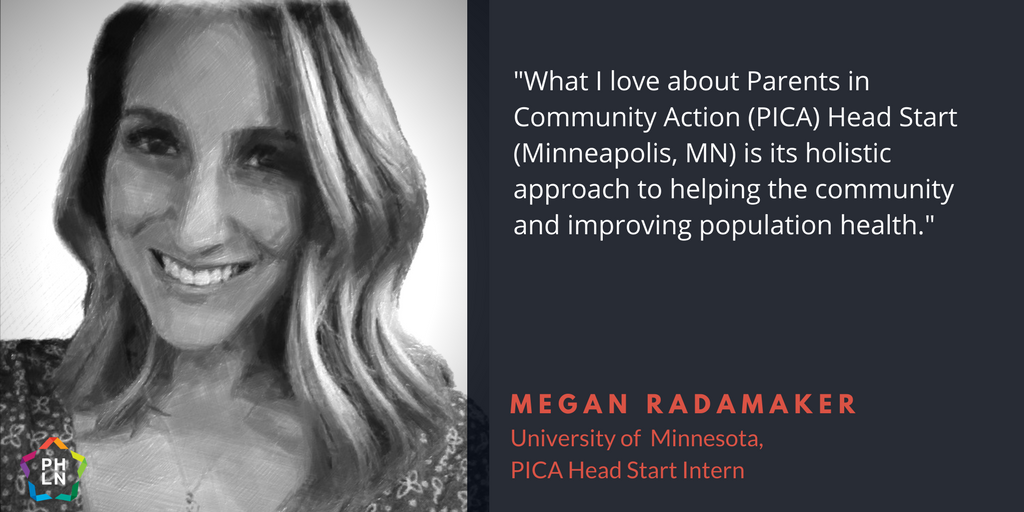
Taking advantage of opportunities provided by Region V – Great Lakes Public Health Training Collaborative, Megan Redamaker, a University of Minnesota Nutrition Coordinated Master’s in Public Health/Dietetics Candidate, found “close to endless” opportunities in her recent dietetics internship with Parents in Community Action (PICA) Head Start in Minneapolis. Among many activities, she participated in parent education sessions to help parents introduce new foods to their kids that not only address good nutrition, but also behavioral issues. She presented at an oral health education seminar for parents on eating foods for oral health. She also enjoyed serving family style meals in classrooms where she could act as a role model for acceptance of healthy foods and foster a healthy and positive environment for enjoying meals. PICA serves healthy and culturally conscious foods for the populations they serve, which includes medically underserved and homeless children living in shelters.
Megan’s work will count towards her hours to become eligible to take the Commission on Dietetic Registration exam to become a registered dietician.
Getting a Grip on Public Health Needs in Nebraska
Gathering Important Data at the Central District Health Department
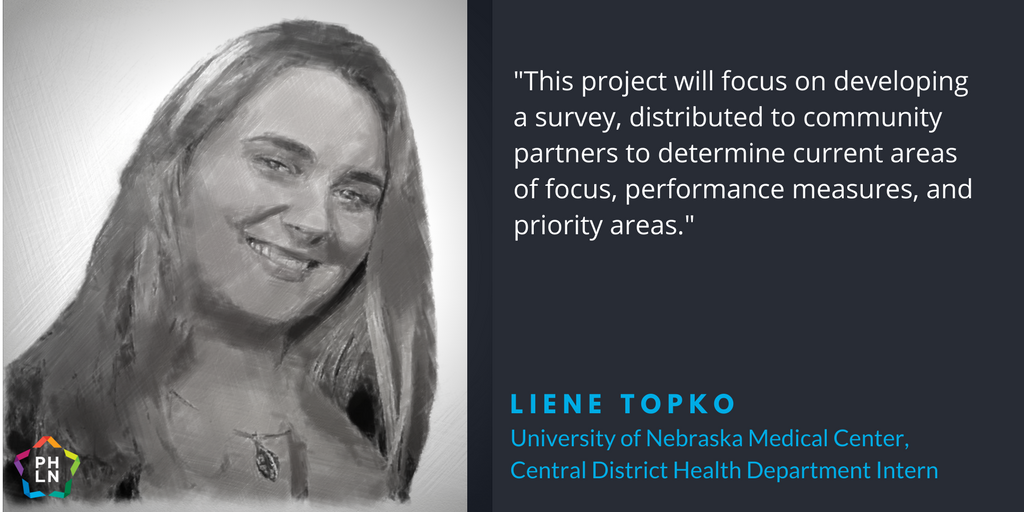
The Central District Health Department (CDHD) tests personal wells, inspects facilities and restaurants, helps prepare for emergencies, runs a Women, Infant, and Children program, conducts immunizations and a diabetes prevention program… the list goes on. Supported by Region VII – Midwestern Public Health Training Center, Liene Topko’s survey project asked community partners to drill down on each of their roles to determine hierarchy and any data or technical needs CDHD might help with today.
To inform improvement of community services and processes, the organization will participate in community-facilitated workgroups and help to develop performance measures and a gap analysis.
Learn more about Liene’s work in her own words »
A Vital Community Health Needs Assessment
Identifying Health Needs and Engaging Communities with the Little Colorado Medical Center in Arizona
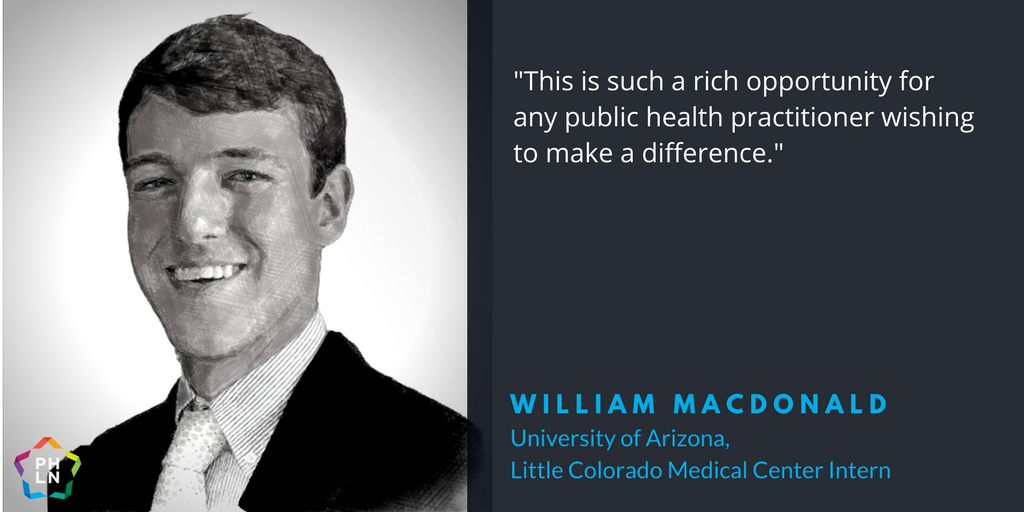
A 25-bed critical access hospital in Winslow, Arizona, Little Colorado serves a huge area and diverse population of which 78 percent are Native Americans – many of whom are in poverty or on the precipice of it. Facilitated by Region IX – Western Region Public Health Training Center, William MacDonald, a public health policy and management student at University of Arizona, took on an important project recently to identify health needs, engage the community, measure progress and inform, and educate and mobilize stakeholders. He pulled and studied patient data, public health outcomes and conducted a community health survey, as well as focus groups and interviews. A community advisory committee was also convened. Findings showed that, though mortalities have declined, mental and behavioral health is a big issue. Little Colorado is stressed with spiking drug and alcohol use, and associated liver, kidney and heart disease.
William’s efforts, along with his colleagues’, have resulted in a renewed emphasis on working with local nonprofits and health agencies. The hospital is making the transition to a rural health clinic, pushing services out into the community, conducting education in schools and sponsoring youth teams.
See William’s video about his internship experience »
Youth Resilience from Cultural Engagement in Arizona
Developing a Native Spirit Program to Increase Hualapai Youth Educational Outcomes
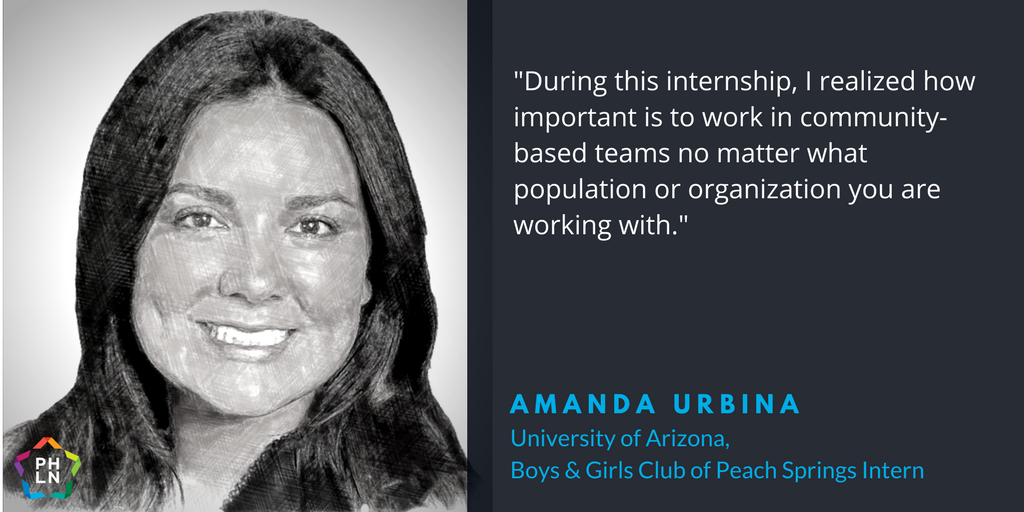
The Boys & Girls Club of Peach Springs in greater Scottsdale, Arizona offers after school programs that deliver a safe place to learn and grow for a population that’s comprised mainly of the youth of the Hualapai Tribe. Supported by Region IX – Western Region Public Health Training Center, focusing on cultural engagement, Amanda worked with stakeholders and developed a 10-session program that focuses on cultural engagement to increase Hualapai youth educational outcomes. She first performed a literature review to inform the program, which yielded information on individual resilience. Cultural aspects unique to American Indians were identified that were needed for the program structure. Fifteen participants were recruited. Working with tribal leaders and other community members, they implemented the Native Spirit Program. A cultural knowledge test and resilience measure were developed and used.
Though the project was limited with a small sample, clear progress and benefits were observed in classroom behavior. Amanda hopes to take her work to the more than 90 Boys & Girls Clubs in other areas.
See Amanda’s video about her internship experience »
Reducing Harm of Opioids Through Consumption Sites
Helping to Inform Recommendations for the First Supervised Sites in the U.S.
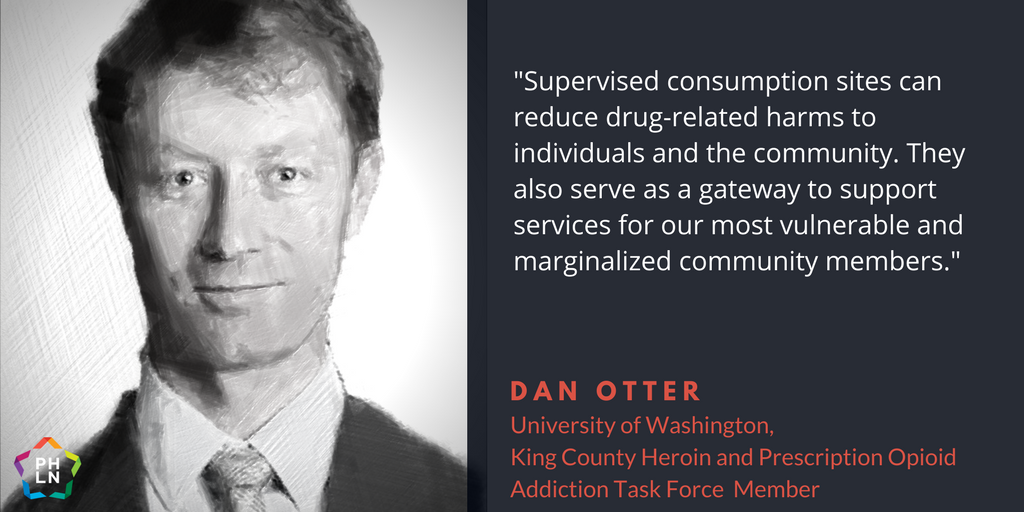
Dan Otter, a graduate student at the University of Washington School of Public Health, evaluated harm reduction at supervised consumption sites in 10 cities abroad and identified best practices. He used a stipend from the Region X – Northwest Public Health Training Center to write up his findings once he returned to Seattle. “Overdose response protocols varied depending on the site’s needs and local context. Nobody has ever died in one of these facilities. Most of the time people just need oxygen. But you need someone there who is able to intervene,” he said. The biggest takeaway? Consumption sites offer support where none often exists. “In addition to promoting survival and health, sites have the potential to engage people, build relationships, connect them with needed services, and most importantly, create a sense of community and acceptance. They’re as much a social service as they are a health service.”
Research that Dan gathered ultimately supported the policies and program implementation of two King County, Washington supervised consumption sites.
Learn more about Dan’s work and experiences »
Learn More
Contact our PHLN members directly to learn about student field placement opportunities across the country.
Email training@nnphi.org to learn more about the National Coordinating Center for Public Health Training’s role in coordinating the development, implementation and standardization of RPHTC student field placements and faculty student collaborative projects.
See the September 2017 edition of Elevate, your resource for lifelong learning »

 Subscribe To Our Communications
Subscribe To Our Communications